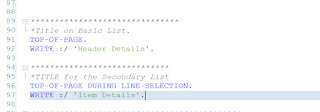Mastering ABAP Events: Unraveling Interactive Classical Report Events and Control Break Statements
Welcome back everyone, We were discussing about Interactive Classical Report Events, So let’s continue it.
3. Top of Page During Line-Selection :-
- This event calls when the first WRITE statement occurs in a program for a page on secondary list.
- The purpose of this event is to provide title/header at the beginning of a new page on secondary list.
Let’s take a requirement to understand it more clearly.
Requirement :-
- I want on the first page my header details should be displayed and on the second page item details should be displayed.
- Also there should be a title for the secondary list.
Code :-
*************************************************************
*Start of Program
*Declaring Strcutrure for header
TYPES: BEGIN OF ty_header,
order_number TYPE zar_order_number,
order_date TYPE zar_order_date,
payment_mode TYPE zar_payment_mode,
currency TYPE zar_curency,
END OF ty_header.
*********************
*Internal table and Work Area
DATA : lt_header TYPE TABLE OF ty_header,
ls_header TYPE ty_header.
****************
*Declaring Strcuture for item table
TYPES: BEGIN OF ty_item,
order_number TYPE zar_order_number,
order_item_number TYPE zar_order_item_number,
item_cost TYPE zar_total_amount,
END OF ty_item.
************************************
*Declaring internal table and work area
DATA : lt_item TYPE TABLE OF ty_item,
ls_item TYPE ty_item.
*******************************
*Variable declaration.
DATA : lv_field(30) TYPE c,
lv_value(30) TYPE c.
*******************************
*Select option Declaration
DATA : lv_order TYPE zar_order_number.
SELECT-OPTIONS : s_order FOR lv_order.
*********************************
*Writing a select query for header
START-OF-SELECTION.
SELECT order_number order_date
payment_mode currency
FROM zar_header INTO
TABLE lt_header
WHERE order_number IN s_order.
***************************************
*Displaying the data
LOOP AT lt_header INTO ls_header.
WRITE :/ ls_header-order_number,
ls_header-order_date,
ls_header-payment_mode,
ls_header-currency.
ENDLOOP.
*********************************
AT LINE-SELECTION.
***********
*GET Cursor Declaration.
GET CURSOR FIELD lv_field VALUE lv_value.
*******************
*Using stored data in GET CURSOR.
IF lv_field = 'LS_HEADER-ORDER_NUMBER'.
SELECT order_number
order_item_number
item_cost FROM zar_item
INTO TABLE lt_item
WHERE order_number = lv_value.
IF lt_item IS NOT INITIAL.
****************************
*LOOP on item
LOOP AT lt_item INTO ls_item.
WRITE :/ ls_item-order_number,
ls_item-order_item_number,
ls_item-item_cost.
ENDLOOP.
ENDIF.
ENDIF.
*******************************
*Title on Basic List.
TOP-OF-PAGE.
WRITE :/ 'Header Details'.
*****************************
*TITLE for the Secondary List
TOP-OF-PAGE DURING LINE-SELECTION.
WRITE :/ 'Item Details'.
********************************************
*End of Program
***************************************************************
Execute the Program :-
1. Basic List
double click on any row.
2. Secondary List
Control Break Statements :-
-
Control break statements are also called as control break events.
-
Control break statements are used to control loop or we can say they are used to control the data flow in loop.
-
Control break statements starts with at and end with endat.
Pre-requisites to apply control break statements :-
- Control break statements should be applied inside a loop.
- Internal table should be in the sorted order.
Types of Control Break Statements :-
- The various control break statements are as follows :-
- AT FIRST :- It triggers for the first row/first iteration of the internal table in loop.
- AT LAST :- It trigger for the last row/last record/last iteration of the internal table in loop.
- AT NEW <fieldname> :- It triggers for the new/first record of a group having the same value for the specified field name in loop.
- AT END OF <fieldname> :- It triggers for the last record of a group having the same value for the specified field name in loop.
Control Break Statements with SUM Statement :-
- SUM statement can only be used in loop-end loop statement and needs to be applied in control break statements (at and endat).
- SUM calculates the sum of all numeric fields to the right of the current group key.
- The sum is for all rows of the current group and assign it to the corresponding component of work area.
Let’s understand the Control break statements with a requirements.
Requirements :-
-
Suppose, this is our order header table.
-
and this, is the data present in it.
-
Now, what Customer wants is, Based upon the payment mode, I should be displaying the Total Amount.
Solution :-
-
Step 1 :- Create a executable program in ABAP Editor.
-
Step 2 :- Declare internal table and work area.
-
Step 3 :- Write Select Queries
-
Step 4 :- Write Control break statements inside the loop.
Code :-
****************************************************************
*Start of Program
**********************************
*Type Structure declaration
TYPES : BEGIN OF ty_data,
payment_mode TYPE zar_payment_mode,
total_amount TYPE zar_total_amount,
END OF ty_data.
***************************************
*Internal table and work area declaration
DATA : lt_data TYPE TABLE OF ty_data,
ls_data TYPE ty_data.
*************************
*Select options
DATA : lv_pm TYPE zar_payment_mode.
SELECT-OPTIONS : s_pm FOR lv_pm NO INTERVALS.
*******************************************
*Writing Select Queries
SELECT payment_mode total_amount
FROM zar_header
INTO TABLE lt_data
WHERE payment_mode IN s_pm.
IF lt_data IS NOT INITIAL.
SORT lt_data BY payment_mode.
*************************************
*Implementing Control Break statements
LOOP AT lt_data INTO ls_data.
AT FIRST.
WRITE :/ 'The Sum based Upon Paymenr mode is as follows'.
ENDAT.
AT NEW payment_mode.
WRITE :/ ls_data-payment_mode.
ENDAT.
AT END OF payment_mode.
SUM.
WRITE : ls_data-total_amount.
ENDAT.
AT LAST.
WRITE :/ 'End of Collection'.
ENDAT.
ENDLOOP.
ENDIF.
*****************************************
*End of Program
************************************
Execute the program :-
- Here, you can compare the output with the data given in the requirement.
- We are getting sum of total amount for corresponding payment mode.
So, that’s enough for today we will continue our journey in the next blog.
Thanx a lot for being a part of this wonderful journey.









.png)
.png)

Comments
Post a Comment